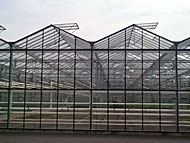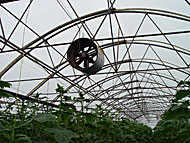
Ventilation in greenhouses
Good ventilation is critical in maintaining an optimal growing environment and improves the overall efficiency of a greenhouse. It is essential for both good temperature and humidity management. Cooling is critical in the Australian environment and is most commonly achieved using passive roof ventilation. The movement of hot air up and out of the roof vents, pulls in cooler air.
Ventilation is also important for air circulation and replenishing carbon dioxide. Poor air circulation reduces plant activity and can lead to problems with humidity and disease management. Air movement in the greenhouse should be between 0.2 and 0.7 metres per second. If carbon dioxide levels are not maintained, plant growth is affected.
Ventilation is about air exchange. Large volumes of air need to be moved during hot conditions. A greenhouse needs to be able to achieve at least 30 air changes per hour, but ideally 60 air changes per hour – one air exchange every minute – is needed to make sure the greenhouse environment can be managed in hot sunny Australian conditions.
Ventilation can be achieved passively or actively. The venting capacity of greenhouses is usually described as a percentage of floor area. For example, a greenhouse with 30% roof ventilation has 0.3m2 of open vent area for every 1m2 of floor area. A greenhouse in all but the coolest areas of Australia should have a venting capacity of at least 25%, but as much as 40% is desirable. It is better to have more venting capacity than you need.
Vents

Passive ventilation uses openings (vents) which naturally draw air through the greenhouse. Vents are the most common ventilation method used in greenhouse production. Roof ventilation is a more effective method of air exchange than side wall ventilation. Though different designs will vary in their effectiveness, in general terms, roof vents are up to 5 times more effective than side wall vents.
The height of a structure and the height of the vents significantly impact on the capacity of a vent to remove heat from the greenhouse. The natural ‘chimney effect’ of rising hot air and falling cooler air which is the basis for passive ventilation becomes truly effective above approximately 3.5 metres. A low profile greenhouse therefore, will require forced cooling to provide similar suitable conditions to a tall structure.
Fans

Active ventilation is the use of equipment to force air into or out of the structure. Fans are the key method of actively venting a greenhouse. Fans can also be fitted in greenhouses to move or circulate air within the greenhouse. Circulating fans are often used inside passively ventilated structures to assist air movement when venting is minimal.
When using fans for air exchange, the most effective approach is to pull the air through the full length of the structure to avoid hot air pockets remaining. Fans placed to extract air from higher in the greenhouse are more effective for cooling than fans which are placed lower.
Active ventilation systems are limited in their capacity to quickly exchange large volumes of air. If the design specifications for your greenhouse are inadequate poor air circulation through the crop can result. Under ventilated structures often have overheating problems in the crop in the middle of the greenhouse. To ensure correct capacity and installation, select the fans in consultation with the manufacturer and an independent expert. Ventilation fans generally need to have sufficient capacity to completely replace the air in the greenhouse every minute.
Fans have an on-going operational cost and noise generation may pose problems in some areas. Fan efficiencies influence running costs and should be considered when purchasing. It is important to clean and maintain fans to ensure that they are functioning properly.

